Association of Residential Greenness with the Prevalence of Metabolic Syndrome in a Rural Chinese Population:the Henan Rural Cohort Study*
HE Ya Ling ,LIU Xiao Tian ,TU Run Qi ,PAN Ming Ming ,NIU Miao Miao ,CHEN Gong Bo ,HOU Jian,MAO Zhen Xing,HUO Wen Qian,LI Shan Shan,GUO Yu Ming,,#,and WANG Chong Jian,#
Metabolic syndrome (MetS),a cluster of modifiable metabolic conditions (including abdominal obesity,dyslipidemia,elevated blood pressure,and hyperglycemia),has become an essential contributor to the global health burden and public health challenges worldwide.The prevalence of MetS was approximately 25% in adults worldwide and 20% in Western countries[1].A similar prevalence has been reported in China[2].Moreover,MetS is a highly age-dependent determinant of both type 2 diabetes mellitus (T2DM) and cardiovascular diseases.Effective prevention and control measures are urgently needed to reduce the risk and disease burden of MetS.
Evidence of the etiology of MetS has suggested that the risk factors for MetS consist of both nonpreventable (genetic variation) and preventable(diet,behavioral,and environmental) factors.In addition,recent studies indicated that higher residential greenness was associated with lower risk of MetS[3,4],by protecting residents against environmental exposures such as heat and high air pollutants levels.A nationwide sister study in the US has revealed that greenness was associated with physical activity,and the association of greenness with obesity could be attenuated by 32% by physical activity[5].However,a recent finding from a cohort study in Germany has shown a negative but nonsignificant relationship between residential greenness and MetS[6].In addition,epidemiological evidence of this association was not found in rural areas with limited medical resources.Therefore,the current study aims to explore the association between long-term residential greenness exposure and MetS in rural China,and to assess whether physical activity and air pollution mediate this association.
The Henan Rural Cohort Study was conducted in five counties of Henan province in central China between July 2015 and September 2017. A multistage,stratified cluster sampling method was used to recruit the participants.A total of 39,259 local permanent residents (18-79 years of age)completely accomplished the baseline survey of the cohort study.After exclusion of people missing important information,39,081 participants were eligible for the final analyses.The Zhengzhou University Life Science Ethics Committee approved the protocol of this prospective cohort study in a large population.Each participant provided signed written informed consent before the start of the baseline survey.
In the current study,MetS was assessed on the basis of the International Diabetes Federation (IDF)definition,according to the suggested ancestry-specific cutoffs[7]:participants with a waist circumference≥ 90 cm in men or ≥ 80 cm in women and with any two of the following criteria were defined as having MetS:(1) triglycerides ≥ 1.7 mmol/L or drug treatment for lipid abnormalities; (2) high-density lipoprotein cholesterol < 1.04 mmol/L in men or < 1.3 mmol/L in women,or drug treatment for lipid abnormalities;(3) systolic blood pressure ≥ 130 mmHg or diastolic blood pressure ≥ 85 mmHg,or anti-hypertensive drug treatment;and (4) fasting blood glucose ≥ 5.6 mmol/L or anti-diabetes drug treatment.
Two satellite-based vegetation indices,the Enhanced Vegetation Index (EVI) and Normalized Difference Vegetation Index (NDVI),were used to assess residential greenness.Both the EVI and NDVI were obtained from the 16-day Moderate Resolution Imaging Spectroradiometer (MODIS) Terra onboard the TERRA satellite (http://modis.gsfc.nasa.gov/data/dataprod/mod13.php).These two vegetation indices were calculated with the land surface reflectance of near-infrared and visible red light.These indices differed in that EVI additionally introduced a blue light band to minimize canopy-soil variations and to improve sensitivity in high biomass regions.The values of these two indices ranged from -0.2 to +1,with negative values representing water,zero value denoting bare soil,and with higher values indicating more greenness exposure.In the main analyses,greenness within 500 m buffer radii and during a 3 year period before the baseline survey was determined and used to indicate long-term exposure in the current study.
Several underlying confounders were considered on the basis of previous literature and the directed acyclic graph (Supplementary Figure S1,available in www.besjournal.com).The continuous variable was age.The categorical variables included sex (male and female),education levels (elementary school or below,junior high school,and high school or above),marital status (married/cohabitating and unmarried/divorced/widowed),average monthly family income(< 500 RMB,500–1,000 RMB,and ≥ 1,000 RMB).Air pollution and physical activity were considered as the mediating variables in the current study.Air pollutants included nitrogen dioxide (NO2) and particulate matters (PM1,PM2.5,and PM10,with an aerodynamic diameter ≤ 1.0 μm,≤ 2.5 μm,and≤ 10 μm,respectively).The daily concentrations of these ambient air pollutants for each participant were estimated at a spatial resolution of 0.1° × 0.1°,and the average exposure concentrations during a three years period before the baseline survey were considered and used to indicate long-term air pollutants exposure.Physical activity was estimated on the basis of metabolic equivalent-hours/week(MET-hours/week) according to the Compendium of Physical Activities,and MET-hours/day was used in the current study.
Mann-Whitney U-test was performed to assess the differences between MetS and non-MetS groups for continuous variables,and Pearson's chi-square test was used to evaluate that differences among groups for categorical variables. The logistic regression model was fitted to examine the association of long-term residential greenness exposure with MetS risk,and the effect estimates were expressed as odds ratios [ORs,95% confidence intervals (CIs)].Restrictive cubic spline analyses were performed to explore the concentration-response relationships (three knots located at the 25 th,50 th,and 75 th percentiles of residential greenness exposure level,respectively).We also examined whether the association was potentially modified by age,sex,and average monthly family income.Moreover,a cross-product term of each potential modifier and greenness indicator was included in the adjusted model to assess the existence of a multiplicative interaction effect on MetS.
Spearman’s rank correlation was conducted to estimate the pairwise correlations between the four air pollutants,physical activity and two vegetation indices.And the association of air pollutants and physical activity with MetS were also estimated.In the current study,mediation analyses were performed. And the product-of-coefficients approach was used to test potential pathways on assocition of residential greenness with MetS,in which the indirect effect could be estimated directly.The total effects,direct effects,and indirect effects were estimated,and standard errors were calculated by generation of 5,000 bootstrap resamples.Moreover,the proportion of the mediation effect was calculated as (βindirecteffect/βtotaleffect) × 100%[8].In addition,to assess the robustness of the findings,we performed several sensitivity analyses,with different definitions of MetS (Supplementary Table S1,available in www.besjournal.com),different buffer radii of greenness (500 m,1,000 m,and 3,000 m),different exposure years of greenness (1,2,3,4,and 5 years),and different approach to test mediating effects (bootstrap and causal stepwise regression approaches).Besides,the associations of greenness with components of MetS were also assessed.andZscore method was used to calculate the continuous MetS severity score,then the relationship between greenness and this score was examined. All statistical analyses were performed in R software(version 3.6.1,R Development Core Team) and SAS 9.1 software package (SAS Institute,USA).
Table 1 describes the distributions of the characteristics of all participants.Among the 39,081 participants in the current study,23,666 (60.6%)were women,and a total of 12,052 participants(30.8%) had MetS.The average age was 57.2 ± 10.7 years in participants with MetS,and a higher proportion was observed in those who reported having elementary school education or below(49.5%) as well as being married/cohabitating(90.2%).In addition,the mean levels of exposure to EVI500-mand NDVI500-min the total population were 0.34 and 0.49,with interquartile ranges (IQRs) of 0.11 and 0.12,respectively.
In agreement with previous studies[3,4],our findings demonstrated an inverse association between residential greenness exposure and MetS prevalence (Table 2). Specifically,for an IQR increment in EVI500-mand NDVI500-m,theORs (95%CIs) for MetS were 0.771 (0.743,0.800) and 0.778(0.752,0.805),respectively,in the adjusted models.Compared with the first quartile level of greenness exposure,theORs (95%CIs) for the fourth quartile of EVI500-mand NDVI500-mwere 0.683 (0.642,0.727) and 0.662 (0.625,0.701),respectively. Moreover,restrictive cubic spline analyses indicated non-linear concentration-response relationships between residential greenness exposure (EVI500-mand NDVI500-m) and MetS (Supplementary Figure S2,available in www.besjournal.com;both the overall association tests and the non-linear association tests wereP< 0.001).
A previous study conducted among 6,076 civil servants of London reported that an IQR increase in NDVI500-mwas associated with a 13% (95%CI:1%,23%) lower risk of MetS[3].In comparison with the results from an earlier study in the Chinese urbanpopulation,the same increase in greenness might have more significant health effects in rural areas than in urban areas [urbanvs.rural:the means of NDVI500-mexposure were 0.32vs.0.49;for an IQR increment in NDVI500-m(0.17vs.0.12),the effect estimates on MetS (0.81 and 0.778) were comparable in the two areas].However,a recent research from the population-based KORA F4/FF4 cohort has found no significant association (P>0.05)[6].Because of the differences in participants’ancestries (Europeanvs.Chinese) and regions (urbanvs.rural),the findings of the current study provide additional evidence of the effect of residential greenness on MetS.

Table 1. The basic characteristics of the participants
Supplementary Figure S3 (available in www.besjournal.com) presents the relationship between residential greenness exposure and MetS prevalence,stratified by age,sex,and average monthly family income.Stronger associations were found in participants ≥ 60 years of age,men,and those with average monthly family income≥ 1,000 RMB.Significant multiplicative interaction effects were detected for age and sex on the associations (allPvalues for interaction < 0.001).We speculate that the findings may be explained by the typical characteristics of rural China.For example,men may spend more time doing agricultural work on farms or labor with more outdoor greenness exposure than women.Older people in rural areas prefer to take walks after meals and look after preschool children in their homes.Furthermore,families with higher incomes may prefer greener living conditions and have better eating habits,thus,potentially affecting the association.
As shown in Supplementary Table S2 (available in www.besjournal.com),the pairwise correlations between air pollutants were highly positive(Spearman's rank correlation coefficients ranged from 0.83 to 0.96),and the correlations between air pollutants and greenness were moderately positive.The associations of air pollutants and physical activity with MetS are shown in Supplementary Table S3 (available in www.besjournal.com).Figure 1 and Supplementary Table S4 (available in www.besjournal.com) show the results of mediation analyses,which suggested that PM1,PM2.5,and physical activity (MET-hours/day) significantly mediated the association between residential greenness and MetS,and explained 30.8%,71.2%,and 10.8% of the effects between EVI500-mand MetS and 29.1%,70.5%,10.4% of the effects between NDVI500-mand MetS,respectively.These findings may be due to the fact that residential greenness helps mitigate air pollution from motor vehicles and other combustion sources,and residential greenness may stimulate a desire for outdoor physical activityamong the population.In the mediation analyses,the total effect was the sum of many potentially different causal pathways (including some that were unmeasured). But we analyzed air pollution(reducing harm) and physical activity (building capacities) in isolation in the current study,which might obscure other unmeasured pathways[9].The interconnected pathways should be considered in future studies.However,in the current study,no significant mediation effects were found for NO2and PM10exposure.That may be explained by the different compositions and origins of air pollutants in different regions,and the strong correlation between NO2/PM10and greenness.

Table 2. Effect estimates of residential greenness on MetS
When MetS was defined by four different definition criteria (Supplementary Table S1),the associations between residential greenness and MetS were similar to the results of using the IDF definition (Supplementary Table S5,available in www.besjournal.com).The effect estimates were stable under different MetS definitions.In addition,Supplementary Table S6 (available in www.besjournal.com) shows that the associations between average residential greenness exposure levels and MetS risk were robust to different buffer radii (1,000 m and 3,000 m) as well as different exposure periods (1,2,4,and 5 years).Moreover,the results of mediation analyses with the causal stepwise regression approach were generally consistent with those of the bootstrap approach(Supplementary Table S7,available in www.besjournal.com). Furthermore,the results of mediation analyses with the bootstrap approach in different greenness exposure years were similar to the findings of the main analyses in general(Supplementary Table S8,available in www.besjournal.com).Besides,Supplementary Table S9(available in www.besjournal.com) demonstrates the associations of residential greenness with the individual components of MetS as well as continuous MetS severity score.
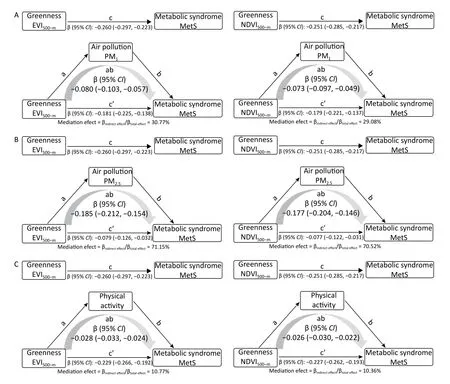
Figure 1.Mediation effects of PM1,PM2.5,and physical activity on the associations of residential greenness with MetS.(A) mediation effects of PM1;(B) mediation effects of PM2.5;(C) mediation effects of physical activity.Adjusted for age,sex,education level,marital status,and average monthly family income.MetS,metabolic syndrome;EVI500-m,Enhanced Vegetation Index across buffers of 500 m;NDVI500-m,Normalized Difference Vegetation Index across buffers of 500 m; PM1,particulate matter with an aerodynamic diameter ≤ 1.0 μm;PM2.5,particulate matter with an aerodynamic diameter ≤ 2.5 μm; CI,confidence interval.
This study was based on a large sample of the Chinese rural population,and the findings might have notable policy implications for increasing residential greenness in rural China.However,several limitations of this study should be noted.Firstly,causality could not be determined due to the cross-sectional study design.Secondly,since the information on variables came mainly from a retrospective questionnaire,the recall bias was inevitable.Thirdly,the greenness was assessed on the basis of geocoded residential addresses from remote sensing,which is a relatively crude exposure assessment approach.More studies should be conducted in the future to assess the health effects of exposure to different vegetation types (such as trees,grass,and shrubs).Furthermore,because vegetation indices represent the overall level of vegetation,in future studies,we may use Google Street View (GSV) and deep learning to calculate the Green Landscape Index (GVI),which refers to greenness from the visual perspective of pedestrians[10]. Fourthly,the current study considered only the type (vigorous,moderate,walking,and sitting),frequency and duration of physical activity,but not whether the activity was performed in green areas or in other settings.Finally,the source of the study population in this cohort was relatively concentrated (Henan province,China),thus,limiting the ability to make comparisons between regions. Comparative analyses of participants from different cohorts could be considered in future studies.
In conclusion,residential greenness exposure was inversely associated with MetS prevalence in rural China,particularly in men,older people,and those with a high average monthly family income.PM1,PM2.5,and physical activity may be involved in the mechanisms underlying the beneficial effect of residential greenness on MetS. Future longitudinal studies are needed to verify our findings.
All authors declare that they have no competing or financial interests to disclose.
The authors thank all participants and coordinators for their support during the research.In addition,the authors thank Dr.Tanko Abdulai for his critical reading of the manuscript.
&These authors contributed equally to this work.
#Correspondence should be addressed to GUO Yu Ming,Prof,Tel:86-371-67781452,Fax:86-371-67781919,E-mail:yuming.guo@monash.edu;WANG Chong Jian,Prof,Tel:86-371-67781452,Fax:86-371-67781919,E-mail:tjwcj2005@126.com
Biographical notes of the first authors:HE Ya Ling,female,born in 1995,Master,majoring in epidemiology of metabolic diseases;LIU Xiao Tian,female,born in 1987,Doctor,majoring in epidemiology of cardiovascular metabolic diseases.
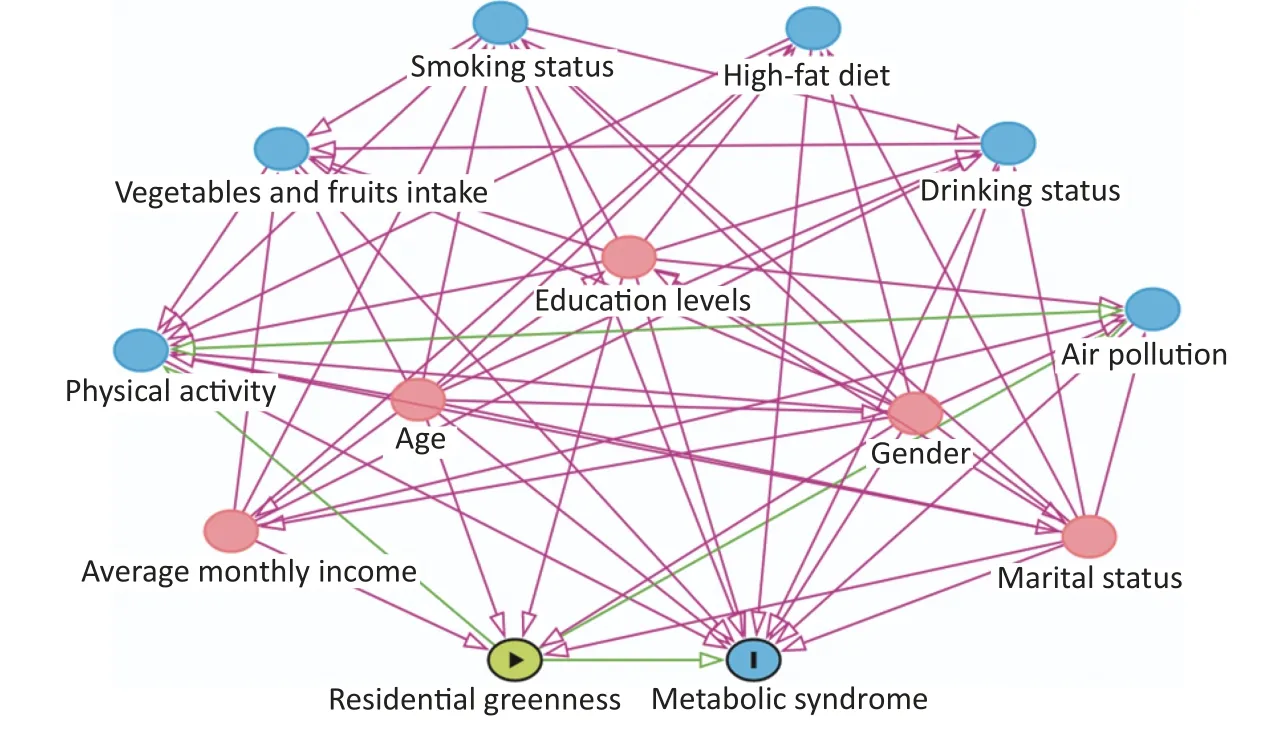
Supplementary Figure S1.Directed acyclic graph for the associations of residential greenness with MetS.Pink lines indicate potential confounders and green lines indicate potential mediators.
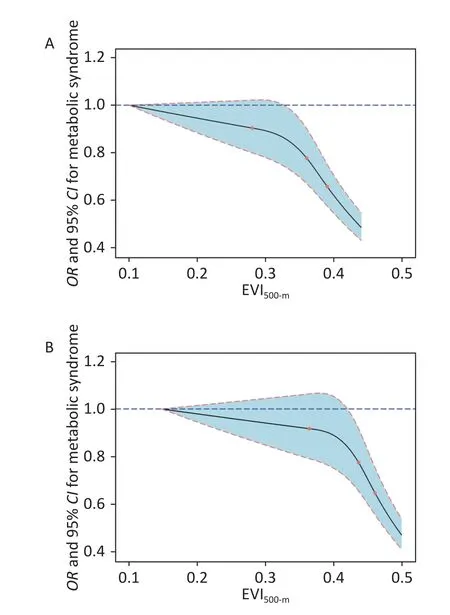
Supplementary Figure S2.The concentration-response relationship for MetS with long-term residential greenness exposure (solid lines,ORs;dashed lines,95% CIs).(A) relationship with EVI500-m;(B) relationship with NDVI500-m.Adjusted for age,gender,education levels,marital status,and average monthly income of family.MetS,metabolic syndrome;EVI500-m,Enhanced Vegetation Index across buffers of 500 m;NDVI500-m,Normalized Difference Vegetation Index across buffers of 500 m.

Supplementary Figure S3.The estimated effects of long-term exposure to residential greenness on MetS stratified by potential confounders.(A) estimated effect of EVI500-m on MetS;(B) estimated effect of NDVI500-m on MetS.Adjusted for age,gender,education levels,marital status,and average monthly income of family.MetS,metabolic syndrome;EVI500-m,Enhanced Vegetation Index across buffers of 500 m;NDVI500-m,Normalized Difference Vegetation Index across buffers of 500 m;ORs,odds ratio;CIs,confidence intervals;P-interaction,P for interaction.

Supplementary Table S1. The diagnosis criteria of MetS based on the different definitions

Supplementary Table S2. Average concentrations and the pairwise correlations of air pollutants,greenness and physical activity

Supplementary Table S3. Associations of air pollutants (PM1,PM2.5,PM10,NO2)and physical activity with MetSa

Supplementary Table S4. Associations between residential greenness and MetS mediated by air pollution and physical activity by Bootstrap approacha

Supplementary Table S5. Sensitivity analyses for the associations between residential greenness and MetS with different definitions of MetS
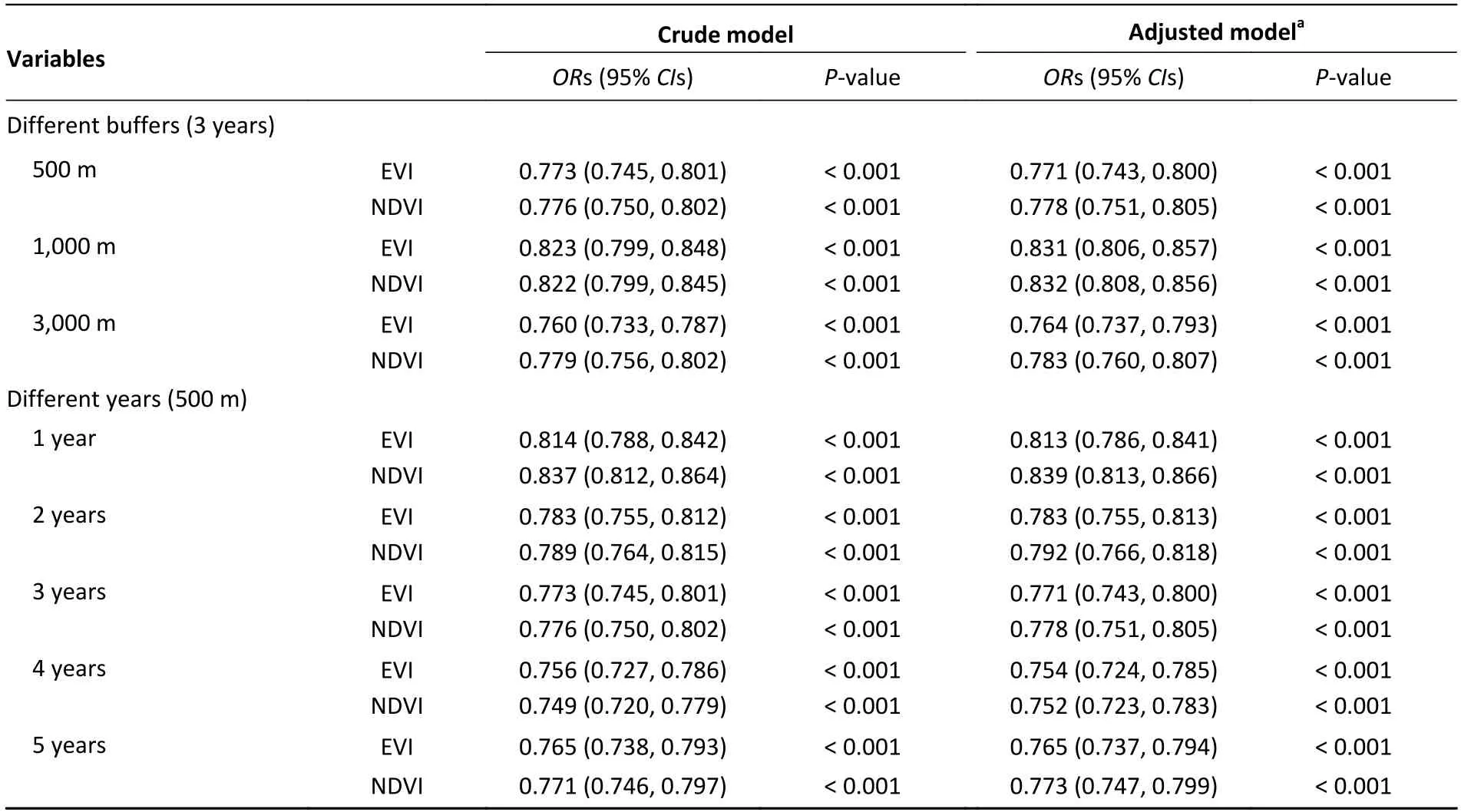
Supplementary Table S6. Sensitivity analyses for the associations between residential greenness and MetS with different buffers or exposure years of greenness
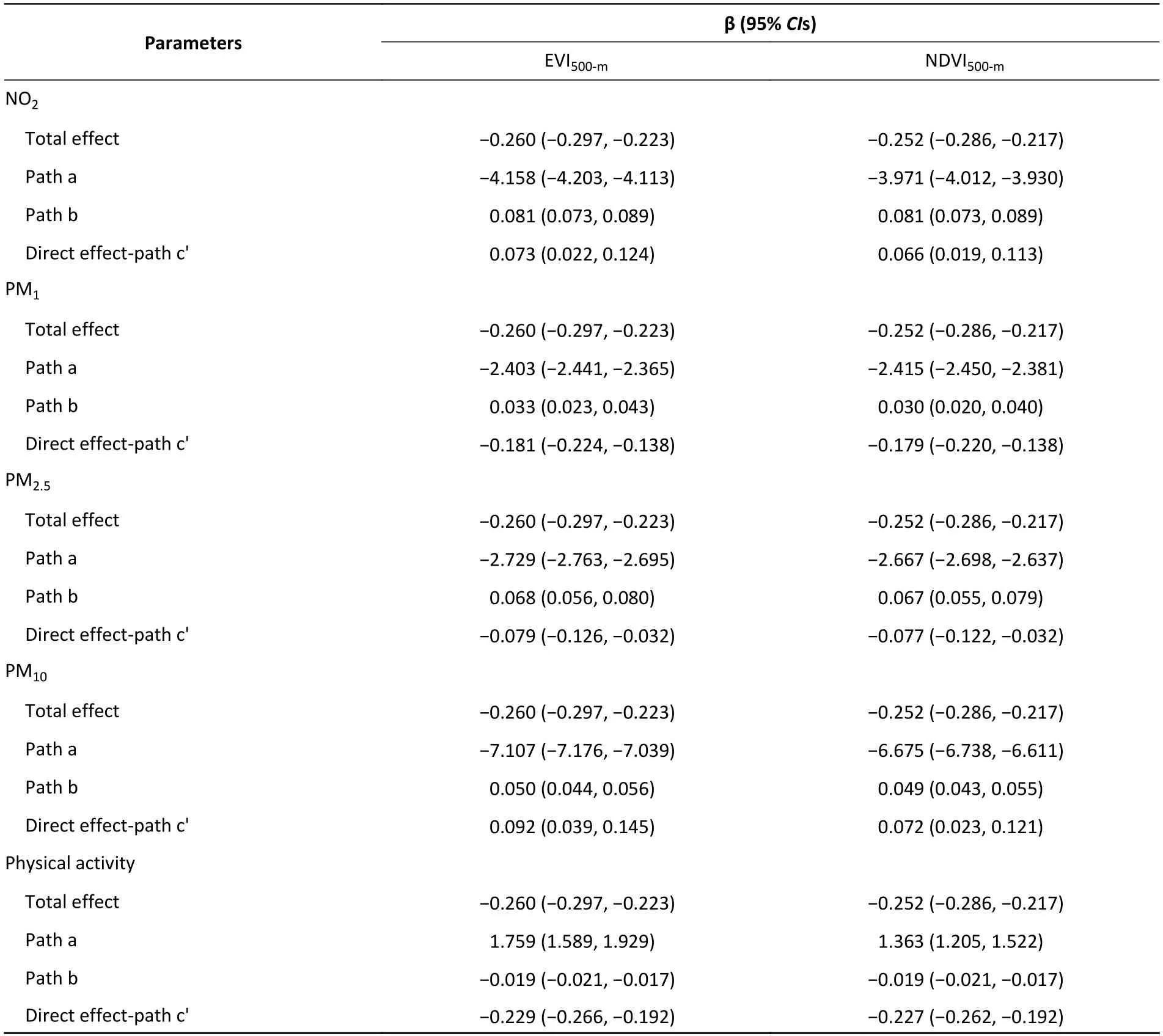
Supplementary Table S7. Associations between residential greenness and MetS mediated by air pollution and physical activity by causal step regression approacha

Supplementary Table S8. Associations between residential greenness and MetS mediated by air pollution and physical activity in different exposure years of greenness by bootstrap approacha

Continued

Supplementary Table S9. Associations of greenness with components of MetS and MetS severity scorea
Received:April 20,2021;
Accepted:September 6,2021
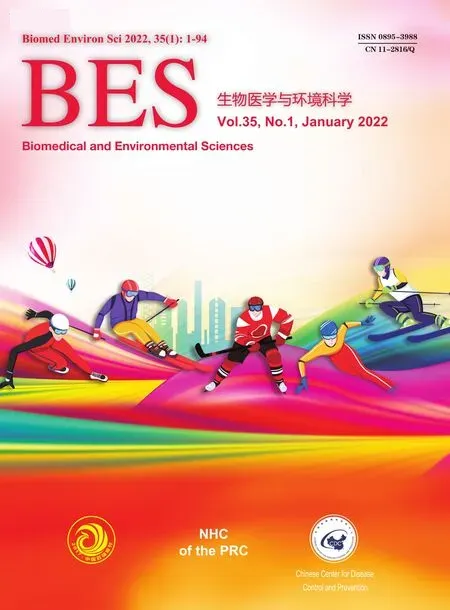 Biomedical and Environmental Sciences2022年1期
Biomedical and Environmental Sciences2022年1期
- Biomedical and Environmental Sciences的其它文章
- Physical Activity Guidelines for Chinese (2021)
- SlRT1 Mediates Sestrin1-lnduced lmprovement in Hepatic lnsulin Resistance*
- An Analysis on Failure Reasons of Quit Smoking among Smokers in Beijing Communities
——Based on a Cross-Sectional Study* - Factors Associated with Diagnostic Delay of Pulmonary Tuberculosis in China*
- Application of Oral Fluid in Measles lgG Antibody Detection for Medical Staff *
- Master Quorum Sensing Regulator HapR Acts as A Repressor of the Mannitol Phosphotransferase System Operon in Vibrio cholerae*
